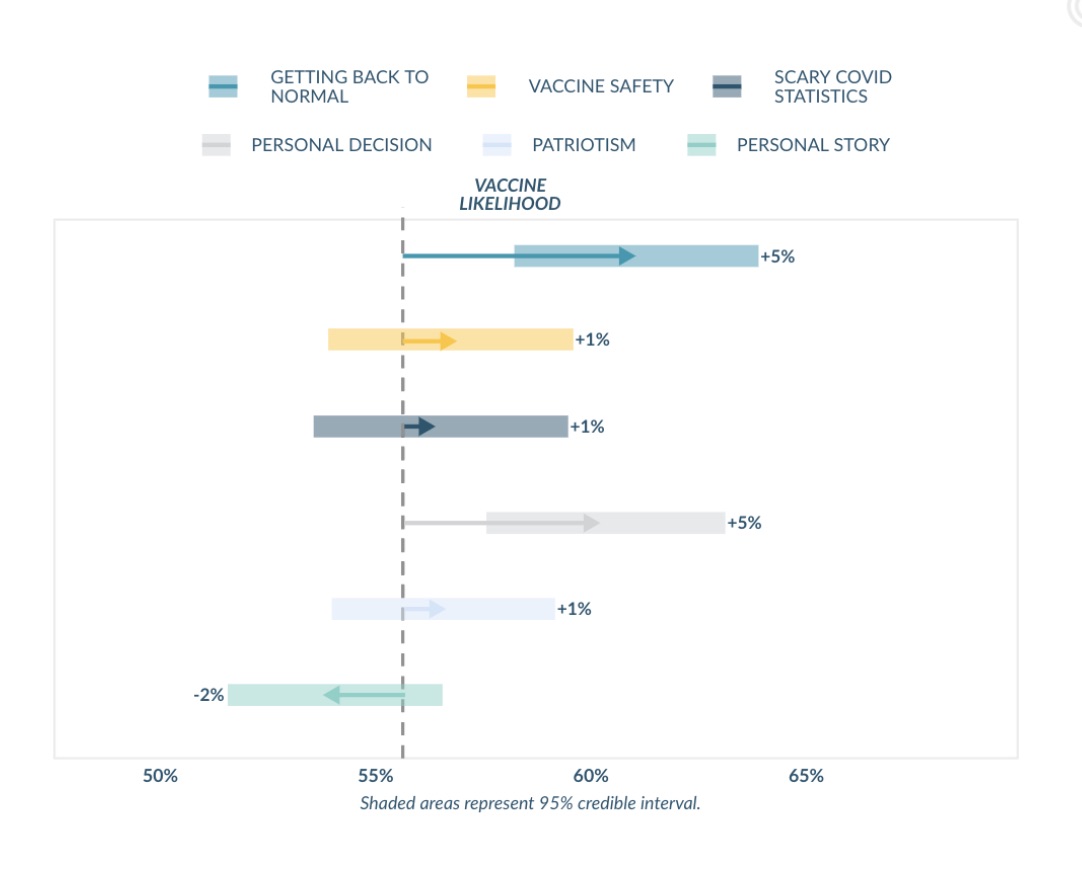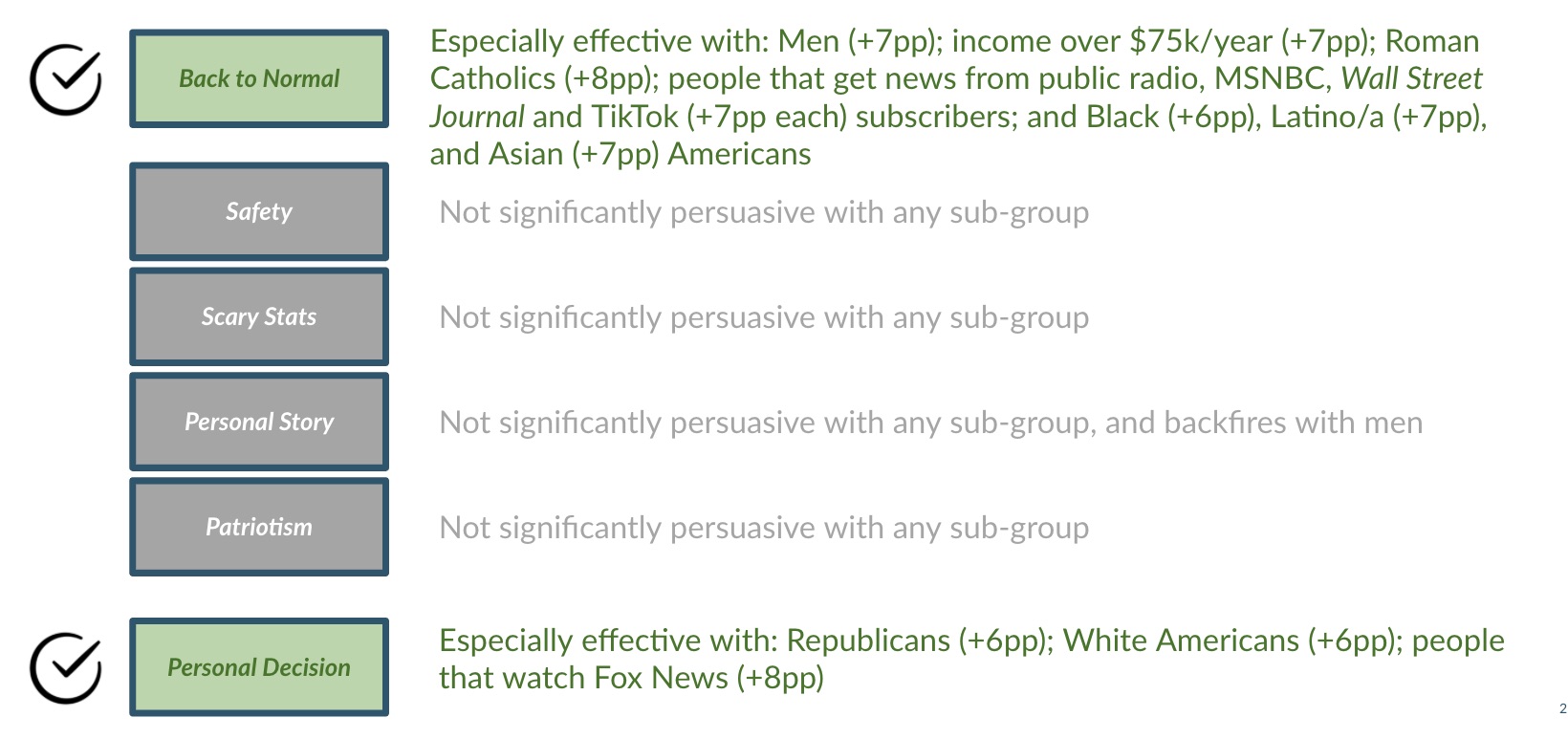Four months after the FDA authorized emergency use of the first COVID-19 vaccine, President Joe Biden announced he is directing states to offer vaccines to all American adults by April…
Five months after critical care nurse Sandra Lindsay entered the history books as the first U.S. recipient of the COVID-19 vaccine, 44.7 percent of her fellow Americans have received at least one dose, and 32.3 percent of the nation is fully vaccinated.
Now for the bad news. There are troubling signs that vaccine uptake rates have already begun to stagnate, signaling the dropoff in demand that some experts predicted.
Changing the minds of COVID vaccine holdouts and skeptics is essential to resuming our everyday lives — and the right public health messaging is essential to turning the tide.
Civis Analytics has studied COVID-19 vaccine messaging in the recent past: click here for our 2020 national study, and here for our 2021 employer-specific study. But we know perceptions and beliefs change over time, so we partnered with Made to Save (a national grassroots effort to ensure communities hit hardest by the pandemic have access to the COVID-19 vaccines and accurate, timely information) to generate ideas for vaccine message frameworks to test, and shared our findings on the recent live webinar Best Practices in Data-Driven COVID-19 Campaigns.
Between April 28 and May 3, 2021, Civis tested distinct message themes in an online randomized controlled trial of 4,215 American adults who are most likely to be uncertain about vaccination. Each participant is a member of one or more of the following “likely to be uncertain” demographic groups:
We tested six messages in all, each with a different reason for why vaccination is important, and all with the same main thrust: You should get vaccinated. Participants viewed one of the following:
Two messages stood out as the most effective to use with all vaccine-uncertain groups: “Getting Back to Normal” and “Personal Decision.” As the chart below illustrates, each increased likelihood to vaccinate by 5 percentage points on average; “Safety,” “Scary COVID Stats,” and “Patriotism” were all ineffective, and “Personal Story” had the highest likelihood of backfiring.

Messaging impact varied across all subgroups in the test, however, as the next chart reveals.

“When you look at specific subgroups, it’s important to look for where you may have a message that performs really well on one subgroup and not another,” Crystal Son, Civis’s director of healthcare analytics, told the Best Practices in Data-Driven COVID-19 Campaigns audience. “Before you run your outreach campaign, take a hard look at who you want to reach out to, and if they comprise more of one subgroup than another.”
The State of Illinois, which has partnered with Civis on a dozen COVID-themed campaigns since the beginning of the pandemic, targeted its vaccine awareness outreach efforts to the so-called “movable middle” — Illinoisans who could be persuaded to receive the vaccine. “We found that these people tended to be younger, female, lower-income, and Black,” Alex Hanns, deputy press secretary to Illinois Governor JB Pritzker, told the webcast audience. “We knew that group was going to change pretty quickly, so we set up a series of surveys so that we could measure that as time went on, and refocus our messaging.”
That messaging includes a series of advertisements featuring trusted messengers like doctors, as well as people who experienced COVID-19 personally, like Julie Sparks, a contact tracer who shares her story in the video below.
It’s working. As of April 2021, 42 percent of Illinoisans are either vaccinated or scheduled to get vaccinated, Hanns said. Among the vaccine holdouts, the movable middle has shrunk from 46 percent of adult Illinois residents in December 2020 to 26 percent as of April, and so-called “likely refusers” have dwindled from 15 percent of residents to 12 percent during the same timeframe.
“We’re using these metrics not only to measure success, but also to understand who we’re speaking to,” Hanns said. “The composition of [the movable middle] has changed and skewed even more towards younger adults, and the differences we saw at the outset with race and gender have balanced out, so we’re taking all of those new data points and restructuring the campaign as we go along.”
For the full findings of Civis’s latest vaccine messaging research, click here.
Civis will continue to study vaccine-related messaging in the weeks and months ahead. With the FDA poised to approve vaccinating teens and children against COVID-19, we will most likely focus next on parents vaccinating their kids. If you have any questions, or want to know more about how Civis can help your organization test and deliver messages that matter, email us at hello@civisanalytics.com.